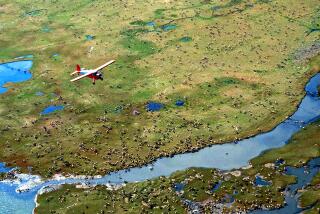Hooked on fishing Alaska
- Share via
PETERSBURG, Alaska -- The average halibut is big and uglier than the inside of a dumpster, as everyone in this little cannery town knows. By big, I mean 100 to 400 pounds, which is why fishermen have suffered broken arms and legs hauling them into their boats. By ugly, I mean flat, blotchy green and toad-like, with both bulging eyes on one side of their head.
Still, seafood connoisseurs consider them the beefsteak of fish. Flaky, fluffy, cotton-white fileted halibut, which sells for about $8 a pound in grocery stores in the Lower 48, tastes like manna from the sea when properly cleaned and prepared. And no fish deep-fries as delectably as these monsters. Dunk a steaming, puffy chunk in tartar sauce and you’ll never say “halibut” and “frozen fish stick” in the same breath again.
Before I took off to go halibut fishing in Alaska in early June, I promised my family and friends that I’d give them fresh frozen filets when I returned. That’s not as big a boast as it sounds, given how easy it is to catch a fish at Rocky Point Resort, nine miles south of Petersburg. Unlike fussy fly-fishing for trout, halibut fishing requires brute strength but precious little finesse.
Although I’m a novice angler, I caught a 30-pound king salmon and three small halibut (20, 30 and 40 pounds) in 2 1/2 days. Walt Payne, who runs Rocky Point with his wife, Susan, and two grown children, Mike and Pam, once hooked a 360-pounder. He says that 10% of the fish caught at the lodge weigh more than 100 pounds.
If you fail to catch anything at Rocky Point, it’s probably because you’ve forgotten to put your line in the water. But if that happens, the scenery and wildlife of Mitkof Island, 123 miles south of Juneau, are glorious compensation. The log lodge and the cabin compound are on the most slender and serpentine section of Alaska’s Inside Passage, known as Wrangell Narrows, a 20-mile-long channel between Mitkof Island and Kupreanof Island to the west. Alaska State Ferries can make it through the skinny channel at high tide, but big cruise ships can’t. That has kept Petersburg, settled by Norwegians in 1891, something of a backwater, with a population of 3,500 and a Norman Rockwell air. Sixteen million acres of Tongass National Forest, mostly on the myriad, puzzle piece-shaped islands of the Alexander Archipelago, surround the lodge, where bald eagles nest in hemlock and spruce trees and bears have gotten into cookie jars on the porch.
Across Frederick Sound to the east rise the Coast Mountains of the mainland, feeding blue ice to LeConte Glacier 17 miles south.
It’s the sort of wild, wonderful country that you would expect to attract only the manliest men, the kind who drink bourbon from paper cups, play poker late into the night, let their beards grow and go out fishing at 4 a.m., even in bad weather. Some who come to Petersburg fit that profile, but not at Rocky Point.
Bud and Barb Whittle, Susan’s parents, built the lodge in 1985. You approach it by a boardwalk through the forest, and the first thing you see is the back porch, where jars contain homemade snickerdoodles, biscotti, chocolate chip cookies and Rice Krispie Treats. The porch yields to Susan’s roomy kitchen, with a wood-fired stove and lace curtains. The walls are lined with open shelves holding glass canisters of pasta, grain and cereal and pretty crockery, including huckleberry-patterned casseroles made by Susan, a potter, painter and jewelry designer.
In the dining room beyond, she and her helpers serve Scandinavian breakfast specialties like Swedish pancakes with sides of sausage or bacon and fresh fruit. Lunches aboard the boats are sandwiches of homemade bread stuffed with roast beef, turkey, ham and egg salad, plus cookies and chips. Feast-like dinners feature seafood, of course; staying at Rocky Point is like having your fish and eating it too. Family recipes include halibut croquettes with salsa and salmon fettuccine, followed by apple pie a la mode or chocolate jelly roll.
Three generations of women--Barb, Susan and Pam--have contributed to a Rocky Point cookbook, started, Susan says, because resort visitors didn’t know what to do with halibut, which has no fat and no oil and fares well only if cooked quickly.
After dinner, you can sit on the porch swing outside the dining room for hours. (In summer, it doesn’t get dark in southeast Alaska until after 10.) Take your sweater and bug repellent because evenings get chilly and mosquitoes can be pesky (though they weren’t in early June). The view of the narrows is better than TV: boat traffic, lodge dogs digging up Susan’s flowers and bald eagles scavenging for clams in the tidal flats that line the channel.
More boardwalks (your shoes don’t have to get dirty at Rocky Point) lead to Walt’s fish-cleaning station and to the six cabins. Five of the cabins have two bedrooms, with two single beds in each; the sixth has a double bed. In the bathrooms, a hot shower is always on tap, and the sitting rooms have refrigerators and heaters, not to mention such flourishes as stained-glass windows and electric boot dryers. The cabins’ sliding glass doors open to porches overlooking the channel. Tackle boxes and fishing rods lean up against the wall in a row, ready for action.
Rocky Point isn’t just for die-hard fishermen. The lodge gets lots of couples, Susan says, and Walt and Mike are happy to take guests on non-fishing excursions to the glacier, Frederick Sound for whale watching in the summer or way out to Coronation Island, at the western edge of the Inside Passage. Some explore Mitkof Island or spend time in town, where there’s a harbor packed with boats, a small local history museum, a landmark 1912 Sons of Norway hall and storefronts on the main street decorated with a form of traditional Norwegian floral painting called rosemaling. But generally, when people who say they don’t want to fish go out on Walt’s cabin cruiser just to see the sights, they find out how easy it is and get hooked.
Rocky Point costs $285 a day, including accommodations, meals, airport or ferry transfers, equipment, fish cleaning and unlimited use of a 16-foot aluminum skiff with a 40-horsepower motor. A fishing license and salmon tag are extra--$20 each for three days (you can get them through the lodge). If, like me, you don’t trust yourself at the helm of a skiff in unfamiliar Inside Passage waters, you can fish from a cabin cruiser captained by funny, patient Walt--or by Mike, who started hunting halibut and salmon around Wrangell Narrows when he was a tyke.
Three days of halibut and king salmon fishing cost me $1,000--not cheap, but still, I came home with 40 pounds of cleaned fish, which would cost $320 in an L.A. market.
The pleasure of zooming south on Wrangell Narrows in Walt’s comfortable 28-foot cabin cruiser is worth a lot, too, especially if the sun is shining, a rare event in persistently wet southeast Alaska. As luck would have it, the weather stayed fair, with blue skies and temperatures in the 60s and 70s while I was there.
On the first day, I went out with Larry and Jeff Tapani, two middle-age brothers from the Portland, Ore., area who seemed to think me something of an oddity. But Walt said that having a novice and bananas on board were good signs. Bananas? Walt says he always catches fish when he has bananas. Moreover, just a week before this trip out, women had snagged all the top prizes in the Petersburg Salmon Derby, so maybe having a woman on board for this ride didn’t bode badly.
In the channel, we passed many of the weathered commercial fishing boats--long-liners for halibut and trollers for salmon--that supply Petersburg’s three canneries, where 73 million pounds of fish, crab and shrimp are processed annually. Later, in town, I met a retired commercial fisherman who told me he’d once caught 55,000 pounds of halibut in 24 hours. The halibut season lasts from March to November, and annual takes are monitored to ensure there will continue to be fish.
Most of the long-liners were going north to Frederick Sound, but we headed for Sumner Strait, south of Wrangell Narrows, Walt’s favorite halibut grounds. He used sonar to locate a hot spot with heavy concentrations of bait fish on which halibut feed. We eventually anchored off Zarembo Island, in water about 90 feet deep, where he put a bleeding slice of herring on my hook and a 16-ounce weight on my line. He showed me how to let the line down straight, then leaned out and tugged hard on it twice, so I’d know what a bite felt like.
Ten minutes later, Larry got the first one. I watched as he set the hook by pulling up sharply on the rod and began to reel it in, which can be hard work. Unlike salmon, halibut don’t fight much or run. But landing a 60-pounder, as Larry did, is like raising a waterlogged sack of potatoes from the depths, requiring considerable upper body strength and sometimes hours. When Larry got the fish close to the boat, Walt killed it with a pistol--more merciful, he said, than bludgeoning it.
I got my 40-pounder right after that, followed in quick succession by 20- and 30-pounders. It took setting the hook and reeling in for all I was worth, with Walt’s help, of course.
The next day, I went fishing with John and Peggy Nielson from Tillamook, Ore., and their son and daughter-in-law, John and Pam Nielson. It was a convivial group; Peggy liked to chat, and John senior liked to tease. But we caught only spiny trash fish called sculpin and halibut too small to keep. So on my third morning out, we tried for king salmon, which had just begun returning to their spawning waters around the narrows. We were fishing with herring as bait again, and for hours we caught nothing. Then I felt a tug on my line. Like an old pro, I set the hook hard and started to reel in. Suddenly I felt the line go slack.
“What’s he doing?” I yelled.
In a flash Walt was at my side, laughing and saying: “He’s running! Keep the line tight!”
Everyone else got out of my way as I ran around the boat, following the fish, trying to figure out what it would do next. Time stood still. Twenty minutes later I landed the 30-pound king.
Hooking a salmon is exciting, and kings are beautiful fish, with plump pink flesh. But you get more poundage for your effort when you catch a homely halibut. And when you eat one fresh out of Sumner Strait, you’ll never judge a fish by its looks again.
More to Read
Sign up for The Wild
We’ll help you find the best places to hike, bike and run, as well as the perfect silent spots for meditation and yoga.
You may occasionally receive promotional content from the Los Angeles Times.






